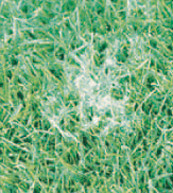Pythium Blight

Pythium blight is among the most destructive of the turf grass diseases, capable of completely destroying established stands within 24 hours after the onset of favorable environmental conditions. More than 148 species are susceptible to this blight, including annual bluegrass, Bermuda grass, colonial bent grass, creeping bent grass, Kentucky bluegrass, rough bluegrass, Italian ryegrass, perennial ryegrass, velvet bent grass, tall fescue, red fescue and red top.
Lesions on individual leaves are water-soaked-green or straw color with no distinct margin separating diseased from healthy tissue. The infected area of turf appears as a circular spot varying from less than one inch to several inches in diameter. In the early morning, the infected plants seem water soaked with a cottony growth on matted leaves. With the onset of lower relative humidity, the growth disappears and the grass blades shrivel and die.
The fungus becomes destructive with an abundance of moisture and warm temperatures (85 F and higher), although infection can occur with temperatures as low as 68 F. Disease development is greater at highly unbalanced nitrogen levels, and in calcium-deficient soils.
Thank you again for visiting our website.
We look forward to hearing from you.
5211 Mahoning Ave. Suite 250 Austintown, OH 44515


